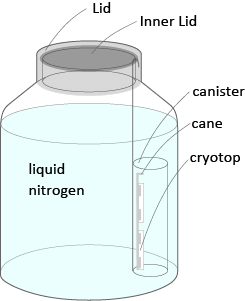
Recently, the cryopreservation of embryos, blastocysts, oocytes, and sperm has become popular.
During cryopreservation, cryoprotectants are added to cells to avoid ice crystal damage before being placed in a liquid nitrogen tank. A special container is used, about which the following 3 points apply.
① The container is meant for temperatures as low as -200°C
② The container is stable for cells like oocytes, etc.
③ The shape makes it easy to collect cells during thawing.
The container also has identifying markers, so that we can always be sure of patients’ ID, name, etc. while using up as little space as possible.


These containers are fixed to a metal device called a "cane", and the cane is placed in a "canister" and stored in a liquid nitrogen tank.
| Number of cryopreservation containers |
|---|
| 1 tank = 6 canisters |
| 1 canister = 40 canes |
| 1 cane = 4 cryotops |
| 1 cryotop = 3 oocytes, OR 1 embryo |